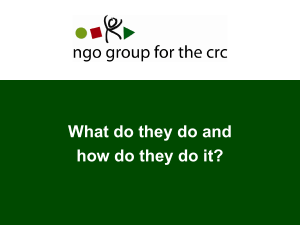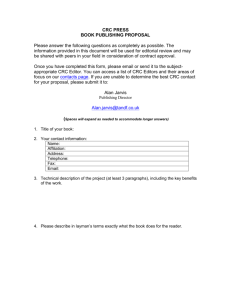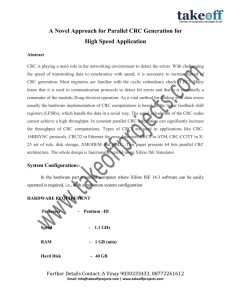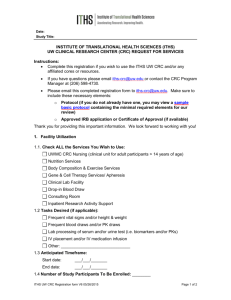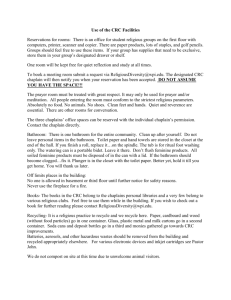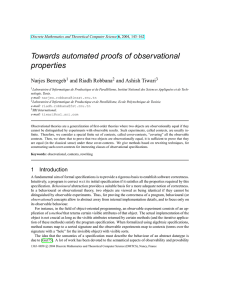Effective engagement with the CRC Committee
advertisement
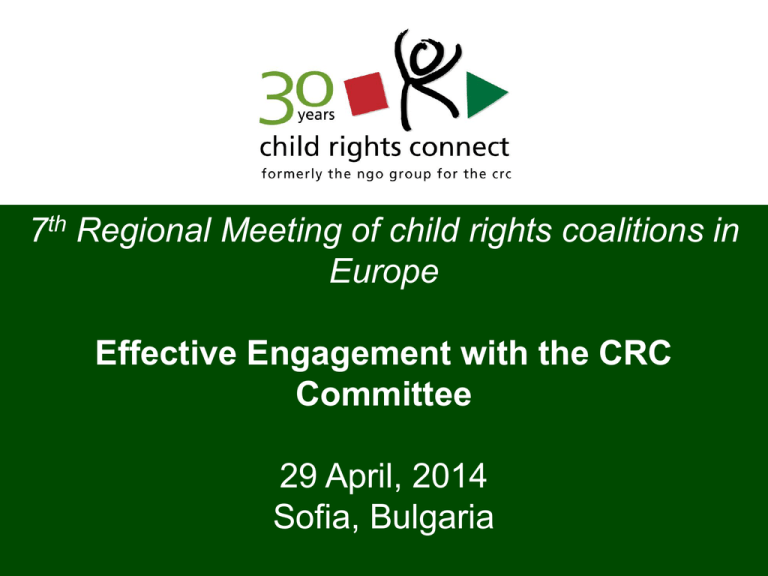
7th Regional Meeting of child rights coalitions in Europe Effective Engagement with the CRC Committee 29 April, 2014 Sofia, Bulgaria Child Rights Connect ’s role Advice and support National NGOs and NHRIs Committee Effective engagement New Child Rights Connect Guide on the CRC Reporting •Specific guidelines on structure, sources, format and timeline for drafting and submitting alternative reports •Tips on how to effectively answer the Committee’s questions •Role and support of Child Rights Connect •Concrete suggestions on follow-up to Concluding Observations (Case studies) Reporting as a Cycle Submission of State party report Submission of NGO reports Implementation of COs ongoing advocacy by NGOs Concluding Observations issued by Committee at end of session Session – all information discussed between Committee & State delegation Written replies sent to Committee Pre-sessional Working Group Considers NGO & other reports List of Issues sent to government Integrated reporting OPAC and OPSC Periodic OP reports should be combined with the State party report on the CRC to produce one integrated report. At the end of the review of an integrated State party report on the CRC, the OPAC and/or OPSC, the Committee will adopt one set of Concluding Observations covering all the treaties covered by the report. Role of coalitions in the CRC Reporting • Providing comprehensive, up-to-date, accurate and objective information • Suggesting concrete and solution-oriented recommendations • Monitoring and advocating for the implementation of the Concluding Observations (CObs) • Supporting children in making their views heard by the Committee Be aware of and build on the advantages of reporting as a coalition • Produce a comprehensive analysis of the implementation of the Convention and its Protocols that can help national monitoring and advocacy • If you speak with one single but stronger voice you will gain legitimacy that will help you building a relationship with government • Strengthen the coalition by strengthening the cooperation with other child rights actors or the broader national civil society to facilitate coherent and collaborative advocacy at national level Face the challenges • Different members’ interests and agendas • Lack of trust and common objectives • Lack of strategy and credibility • Difficulty in sustaining active interest • Poor management and coordination • Lack of funding and resources CRC Reporting: A tool for change Child rights & realities Gaps on child rights Priority problems & violations Proposed solutions Think strategically LINK the CRC Reporting to your work and BE Goalorientated ! What do you want to change? What will your strategy be to bring about that change? Who will your key partners be? Why the CRC and not another human rights mechanism? How can your work benefit from the CRC reporting? Focus on influencing the CObs Produce SMART recommendations to ensure that the CObs will be a support tool for your advocacy and the design of your activities What are the Concluding Observations? • They are not legally binding but they are the result of the expert analysis of States’ legal obligations • They define and prioritise the actions that need to be taken to enhance the realization of child rights • They should make a constructive contribution to national problem-solving and to provide a structured framework for dialogue with the authorities • They should form the basis for periodic evaluation and followup Follow-up to concluding observations Basis for NGO participation in follow-up The Committee recommends that the State party further encourage the active, positive and systematic involvement of civil society, including NGOs, in the promotion of children’s rights, including their participation in the follow-up to the concluding observations of the Committee. - 2006 Concluding Observations of Swaziland At national level, the Committee depends on national non-State actors to ensure that its recommendations are being implemented by the State. Why civil society should follow up on the CObs? Achieving the change we are seeking for children require the engagement of society as a whole, including NGOs and children • • • • Because the CObs carry weight as the States have obligations to follow-up Because it is no longer NGOs but the international body who has the mandate to tell State how they should fulfil their obligations Because CObs often reflect NGOs’ recommendations Because without follow-up reporting becomes an adhoc exercise Challenges and obstacles • Unclear role on NGOs (no formalised process) • The Committee does not have a formalised procedure • The length and the structure of CObs • Lack of awareness and understanding of the treaty body mechanisms within the ministries responsible of follow-up • Difficulties in maintaining the momentum and insufficient resources and time The right approach for coalitions Take into account all UN Human Rights mechanisms’ recommendations and integrate them into your ongoing monitoring and advocacy Recommandations Monitoring Recommandations Recommandations Alternative Reports Advocacy Beyond the reporting process… . • 25th Anniversary of the CRC 24 September 2014 • Days of General Discussions 12 September 2014 “Social media and children’s rights” • General Comments “Public spending” and “Adolescents” What is effective engagement? • Be aware of processes and opportunities and plan accordingly • Disseminate the information and find allies • Make use of the main entry points and anticipate deadlines • Understand and use the outputs in a strategic way at national level • Link international processes and outputs to national and regional strategies Useful Tools Thanks for your attention! Questions and Answers

